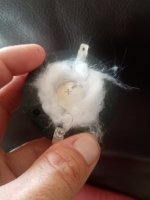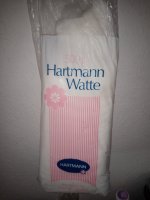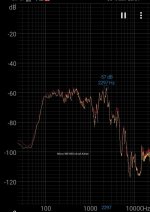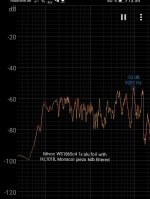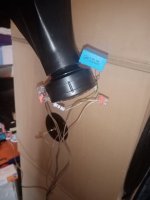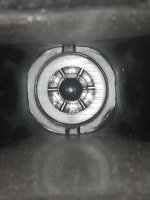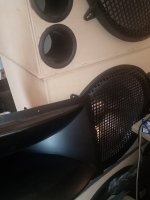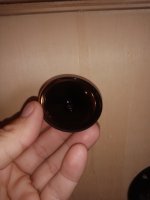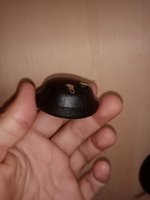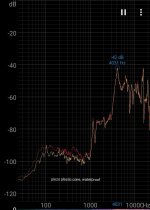found here measurements of someone damping the piezo disc and the cavity behind the cone
https://techtalk.parts-express.com/forum/tech-talk-forum/54923-grs-2x5-tweeter-mods
https://techtalk.parts-express.com/forum/tech-talk-forum/54923-grs-2x5-tweeter-mods
I've experimented with them a lot. TLDR, use a steep DSP high pass at 10k and a few spots of lacquer on the rim and they are the best super tweeter money can buy.
The original (and excellent) Motorola piezo's incorporated damping of both the 'disc' and space behind.found here measurements of someone damping the piezo disc and the cavity behind the cone
https://techtalk.parts-express.com/forum/tech-talk-forum/54923-grs-2x5-tweeter-mods
The very best quality piezo drivers are sold by:
http://122.55.220.155/piezo/about-us.php
http://bestgrouptechnologies.com/piezosource-home.php
found the ksn 1188 here which seems to be technically interesting
https://www.adelcom.net/MOTOROLA_ksn1188a.html
but at a price above 50 dollars you get already decent classical horn drivers which put out ten db more in the mids
https://www.adelcom.net/MOTOROLA_ksn1188a.html
but at a price above 50 dollars you get already decent classical horn drivers which put out ten db more in the mids
I'm a bit perplexed at the moment as piezo tweeters usually have some typical piezo resonances.
Have now a Monacor MPT-142 piezo driver on a big HL1018 horn but at a quick listen it makes no obvious faults and has low distortion. No tizzy sounds at all.
it has 91ohms across 2.2 uF in line and 12 ohms in line.
Piezo paper cone both sides aluminium foil (sandwich) applied and with medical cotton damped.
Quick and dirty test with an aluminized 18inch driver which goes up to 2khz, no filter.
Will reduce the 2.2uF on the piezo to 1uF.
No name piezo driver with same treatments sounded well but had some annoying tizz in the highs. But quite similar F response.
Measured Mivoc WS1865c4 bass, tweeter MPT-142 +HL1018 horn and combined measurement
Have now a Monacor MPT-142 piezo driver on a big HL1018 horn but at a quick listen it makes no obvious faults and has low distortion. No tizzy sounds at all.
it has 91ohms across 2.2 uF in line and 12 ohms in line.
Piezo paper cone both sides aluminium foil (sandwich) applied and with medical cotton damped.
Quick and dirty test with an aluminized 18inch driver which goes up to 2khz, no filter.
Will reduce the 2.2uF on the piezo to 1uF.
No name piezo driver with same treatments sounded well but had some annoying tizz in the highs. But quite similar F response.
Measured Mivoc WS1865c4 bass, tweeter MPT-142 +HL1018 horn and combined measurement
Attachments
Last edited:
nice measurements here of a big peavey horn using piezos
Its showing what is to be expected from the use of a bigger horn. Contrary to dynamic drivers in such horns - below 3 khz there is a drop in response.
https://ampslab-spk.com/2020/10/24/peavey-piezo/
Its showing what is to be expected from the use of a bigger horn. Contrary to dynamic drivers in such horns - below 3 khz there is a drop in response.
https://ampslab-spk.com/2020/10/24/peavey-piezo/
Attachments
Investigated some tweaks I usually do. Most effective is the damping of the back cavity with medical cotton. (more in the thread How to make a loudspeaker sandwich cone).
Here two drivers, one with damping of the back cavity, the other one without. Both have aluminium foil (sandwich) on the piezo paper cone. The foil brings resonances down but damping of the cavity is most effective (and easier to realize).


Here two drivers, one with damping of the back cavity, the other one without. Both have aluminium foil (sandwich) on the piezo paper cone. The foil brings resonances down but damping of the cavity is most effective (and easier to realize).
The Monacor MPT-142 piezos wins over the no name piezo drivers on linearity showing no severe dip in the 6-8khz region.
All four no name piezo drivers (original, 1xfoil, 2xfoil, 2xfoil plus damping show the same dip in the region of 6-8khz and could not be tamed with these kinds of treatment.
Cavity damping reduced the long decay in the lower region (4 to 6 khz) to an extent that it allows for a decent hifi - alike presentation unusual for piezo drivers which are associated with "tizzy" sounds immediately detectable by the ear and what most people repels from their use. A listening test showed very acceptable sonic result.
The Monacor seemed "tizz" free on a quick listening test, the noname piezo remained tizzy.
Overall sound gut much better from the raw untreated driver to the treated ones. But only the quality piezo disc made the final and important difference.
After this further treatments like damping the piezo disc with some damping sealant like silicone or suspending the piezo disc (like seen in the bigger legendary Motorola piezos) is not worth for further investigation as already a decent result can be obtained by good cavity damping with medical cotton wool and using the better quality piezo driver.
All four no name piezo drivers (original, 1xfoil, 2xfoil, 2xfoil plus damping show the same dip in the region of 6-8khz and could not be tamed with these kinds of treatment.
Cavity damping reduced the long decay in the lower region (4 to 6 khz) to an extent that it allows for a decent hifi - alike presentation unusual for piezo drivers which are associated with "tizzy" sounds immediately detectable by the ear and what most people repels from their use. A listening test showed very acceptable sonic result.
The Monacor seemed "tizz" free on a quick listening test, the noname piezo remained tizzy.
Overall sound gut much better from the raw untreated driver to the treated ones. But only the quality piezo disc made the final and important difference.
After this further treatments like damping the piezo disc with some damping sealant like silicone or suspending the piezo disc (like seen in the bigger legendary Motorola piezos) is not worth for further investigation as already a decent result can be obtained by good cavity damping with medical cotton wool and using the better quality piezo driver.
It must be said that the listening test was quite impressive as the use of a correct 6db filtering with all the treatments showed the dynamic possibilities of horn loading and typical dynamic sounding "piezo attack" (due to lightweight resonant construction).
Its for the nice "piezo attack" I did all this investigation in order to find out what can help the piezo driver to perform better.
As a fullrange driver fan there are two ways I consider the use of the advantage of fullrange drivers as good paths to follow:
as the most important region for phase linearity is the region of 200 hz to 5khz you can use:
a) typical standard bass drivers which have a "peaceful" upper end (alu foil tweak can help to improve this) and add a tweeter of any kind - piezo tweeters would be ideal as they are able to cover the region of 4 to 20 khz as a "helper tweeter".
b) or you use a fullrange driver and linearize it with EQ if needed to get linear response
Its for the nice "piezo attack" I did all this investigation in order to find out what can help the piezo driver to perform better.
As a fullrange driver fan there are two ways I consider the use of the advantage of fullrange drivers as good paths to follow:
as the most important region for phase linearity is the region of 200 hz to 5khz you can use:
a) typical standard bass drivers which have a "peaceful" upper end (alu foil tweak can help to improve this) and add a tweeter of any kind - piezo tweeters would be ideal as they are able to cover the region of 4 to 20 khz as a "helper tweeter".
b) or you use a fullrange driver and linearize it with EQ if needed to get linear response
the piezo with a plastic cone (post 50 in this thread) is worth for further investigation:
easy to make a hole in the back cavity and add some damping.
Its already pretty linear and has a good cone material I prefer over paper alone.
Its got no horn and it might well match typical loudspeaker drivers in sensitivity.
It would be great if the tizzy sound could be tamed for their use as indirect radiating tweeters.
Indirect radiating tweeters pointing to the ceilink or the sides / back are of great help for fullrange drivers to give good off axis frequency response:
the fullrange driver could stay linear on axis and the indirect tweeters help giving the desired even room response where multi way loudspeakers perform usually better.
easy to make a hole in the back cavity and add some damping.
Its already pretty linear and has a good cone material I prefer over paper alone.
Its got no horn and it might well match typical loudspeaker drivers in sensitivity.
It would be great if the tizzy sound could be tamed for their use as indirect radiating tweeters.
Indirect radiating tweeters pointing to the ceilink or the sides / back are of great help for fullrange drivers to give good off axis frequency response:
the fullrange driver could stay linear on axis and the indirect tweeters help giving the desired even room response where multi way loudspeakers perform usually better.
The frequency response + efficiency is probably useful for PA use but it is certainly NOT Hi Fi.nice measurements here of a big peavey horn using piezos
Its showing what is to be expected from the use of a bigger horn. Contrary to dynamic drivers in such horns - below 3 khz there is a drop in response.
https://ampslab-spk.com/2020/10/24/peavey-piezo/
Many years ago, when I set up a Dolby Prologic sound system, I added a KSN1025 copy to the rear wall mounted rear speakers BUT >easy to make a hole in the back cavity and add some damping
I completely removed the 'back cavity' cover and mounted them so that the 'rear piezo disc' faced outwards, and had the horn output
facing the wall to achieve a large amount of reflected sound. I seemed to work quite well despite Prologic being bandwidth limited to 10Khz.
PS.
Although I haven't done it, I would be very curious about the results if the 'open rear' of a piezo horn had a DIY horn added to the rear >
thereby creating a 'bi-directional tweeter' providing both direct and reflected sound 🙂
@Audio>X
never tested open tweeters like Heil air motion transformers usually being backside open.
I think it can work out well as frequencies above 5khz are not critical concerning phase response. From theory.
However I use indirect radiating tweeters for fullranges and here there is definitely one turn of phase to be auditioned which one sounds better.
Its subjective. Until today I don't know if its a delay which sounds better helping spatiality or time alignment giving more coherent impulse response.
never tested open tweeters like Heil air motion transformers usually being backside open.
I think it can work out well as frequencies above 5khz are not critical concerning phase response. From theory.
However I use indirect radiating tweeters for fullranges and here there is definitely one turn of phase to be auditioned which one sounds better.
Its subjective. Until today I don't know if its a delay which sounds better helping spatiality or time alignment giving more coherent impulse response.
Too much "grass" in the frequency response, please use 1/12 octave smoothing.Measured...
Piezo paper cone both sides aluminium foil (sandwich) applied
With the 'foil sandwich' there certainly would be a break-in time as the glue 'cures & ages'.I wonder if there is a break in for piezo drivers?
- Home
- Loudspeakers
- Multi-Way
- Are Piezo Tweeters frowned upon?
